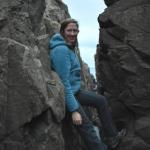Support
My favorite part of spending time in a forest is being surrounded by patterns of green. Tiny star-bursts of moss, curving upright sprays of ferns, thin sweeping lines of grass, bristly erect triangles of spruce. Every plant, tree or moss or fern, shapes and layers its leaves in a different way, so that there is an endless complexity of form and line to marvel at. For as long as I can remember, I’ve loved learning to recognize the different patterns unique to each species, memorizing common names and Latin epithets alike. Every time I visit a new place, I try to learn a few new plants to go with it.
While studying abroad in Denmark, I was able traveled to Stockholm, Sweden to pursue my love of plants thanks to the enrichment grant I received from Paul Gilbert and Patricia Romeo-Gilbert. My main reason for visiting Stockholm was to see the Royal Museum of Natural History, which houses a collection of Carl Linnaeus’s herbarium specimens. Linnaeus was a Swedish botanist who pioneered the binomial classification system which is now used to classify all organisms. While in Stockholm, I also visited Tyresta National Park, a small area of primeval forest – which has never been logged – preserved impressively close to the city. My plan was to combine the knowledge of botanical specimens I would gain at the museum with plant sketches made in Tyresta National Park to create an illustrated portrait of the park’s biodiversity.
My first full day in Stockholm, I took advantage of the – relatively – nice weather, and took the bus to Tyresta National Park. I spent the day wandering along the park’s many hiking trails, sketchbook in hand, doing my best to capture the many leaf-patterns around me. Despite the fact that it was November, long after the forest’s deciduous plants had lost their leaves, there was plenty to draw. I was particularly impressed by the diversity of mosses and lichens – it seemed that every boulder had a new moss-shape on it. I ran out of daylight long before I ran out of plants, and I hiked back to the bus stop in the gathering twilight while a gaggle of ravens made fun of me.
The next day, I went to the Royal Museum of Natural History. It is an impressively large and complex museum, and I somehow managed to spend nearly eight hours wandering through it. The clear highlight of the visit was getting to see some of Linnaeus’s herbarium collection. As the majority of the specimens are not part of a public exhibit, I had arranged to meet with the museum’s Herbarium Manager, Johannes Lundberg. He showed me a variety of preserved plants – both collections made by Linnaeus and modern specimens for comparison. I had come to the museum to learn about Linnaeus, but thanks to Mr. Lundberg’s wealth of knowledge and enthusiasm, I ended up with an understanding of the history and significance of botanical collections in general.
The things I learned in Sweden have helped me narrow down my options for what part of biology I want to specialize in – botany is certainly near the top of the list! My learning on campus has also benefited from this trip – I’ve been making connections between my experience in Sweden and my course material. I’m currently working on digitally coloring my Tyresta sketches and combining them with the photographs and notes I took at the museum, and I hope that the final product will inspire others to marvel at plants – abroad or just in their own backyards!
